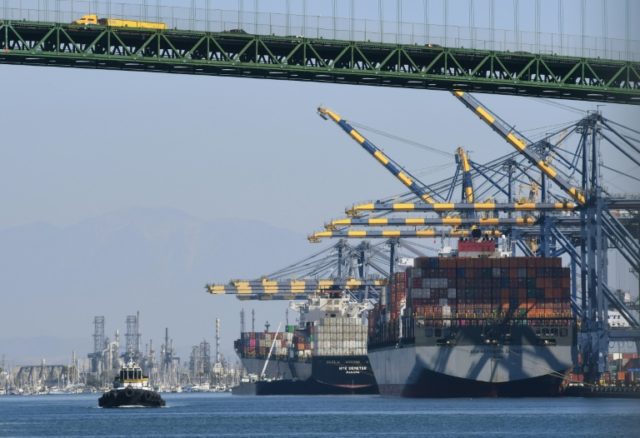Data released by the Chinese government on Monday showed the economy growing at the slowest pace since 1990, but Chinese media took the slow growth as evidence of the Chinese economy’s “resilience” in the face of the U.S. trade war, presumably on the theory that it could have been much worse.
China’s economic growth slowed to 6.4 percent in the last quarter of 2018, bringing the overall rate for the year down to 6.6 percent. The rate in 2017 averaged 6.8 percent.
AFP quoted analysts who believe “the worst is yet to come,” as China’s stock market gets more jittery, the currency grows weaker, infrastructure projects stall because government funds have been redirected to debt reduction, and consumers suffer from a combination of slow income growth and tight credit.
Furthermore, as AFP noted, Chinese government at all levels has a habit of fudging and falsifying economic data, so economic fundamentals might be in substantially worse shape than the disappointing fourth-quarter numbers suggest. Some analysts believe China’s growth rate could be fully 2 points worse than the official numbers indicate.
Chinese media did their best to put a positive spin on the economic report. The state-run Global Times, for example, called the growth rate “reasonable,” insisted the consumer economy is still humming along and blamed American “unilateralism” for the loss of confidence in Chinese markets.
The Global Times quoted analysts who felt China’s biggest problem is how to harness the amazing economic power its brilliant reforms will unleash once the U.S. trade war is no longer keeping it down:
“US unilateralism, protectionism, and the China-US trade tensions have affected market confidence, causing private sector investment to slow in China,” said Cong Yi, a professor at the Tianjin University of Finance and Economics.
Trade frictions’ influence to market confidence became more apparent in the fourth quarter, weighing on China’s economic growth, said Cong.
“The China-US trade tensions, a hindrance to China’s domestic economic transformation and upgrading, coupled with lack of confidence from investors, resulted in the nation’s declining GDP growth in 2018,” said Dong Dengxin, director of the Finance and Securities Institute at Wuhan University of Science and Technology.
However, experts said China’s main pressure comes from how to unleash the potential of its market via deepening economic reforms.
Even if the Sino-US trade friction continues in 2019, China’s economic situation will not be worse than 2018 as it is now fully prepared for the future economic moves, said Dong.
Cong said China could achieve an 8 percent GDP growth rate if it fully taps the country’s potential.
Another Global Times editorial said China was growing too fast in previous years and the current rate is the ideal speed to avoid crashing when it hits a curve:
The lowest growth rate does not indicate that China’s economy is facing a crisis. Instead it’s a process of resolving tough problems, controlling serious risks and finally realizing a soft landing. China adjusted its economy and maintained medium-to-high-speed growth, showing resilience as the world’s second largest economy.
World public opinion mentioned that when facing downward pressure, China ruled out a flood of stimuli such as the 4-trillion yuan infrastructure investment of a decade ago. This is because the Chinese government is confident in the country’s economic fundamentals and China’s economic structure has changed greatly in the past decade. In 2018, China had more moderate policies to stimulate its economy.
If China’s governance were the same as the US and Europe’s, the country would experience an economic crisis after decades of rapid development, just like the US suffered in 1929. This is why some Western people have agitated for a “China collapse theory.” But China’s systematic advantage helps the country to mitigate risks, resolve problems and progress.
This is not sophistry, but an actual fact of the Chinese economy. The country’s infrastructure is people-oriented. Food security, education, medical treatment and other areas involving people’s livelihoods are becoming the directions for investment.
Chinese Communist Party leader Xi Jinping told the same story at a political function in Beijing on Monday, ostentatiously telling top officials to focus on “defusing major risks to ensure sustained and healthy economic development and social stability,” as the state-run Xinhua news service put it.
“In his speech, Xi analyzed and raised specific requirements on the prevention and defusion of major risks in areas including politics, ideology, economy, science and technology, society, the external environment, and Party building,” Xinhua said.
CNBC saw a few bright spots in the Chinese economic report, such as better-than-expected industrial growth and retail sales data, but then noted some of this seemingly positive news is actually a short-lived artificial boost caused by “exporters rushing to ship their goods out of China before new U.S. tariffs hit.”
“While official data indicated China’s economy held up for much of last year, it now appears to be slowing. Production metrics and export orders are falling as the country’s trade dispute with the U.S. drags on and other factors weigh on growth,” CNBC reported.

COMMENTS
Please let us know if you're having issues with commenting.